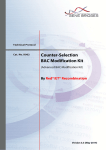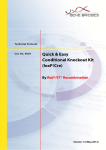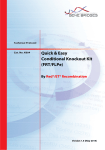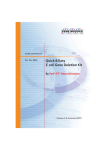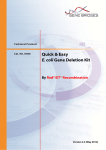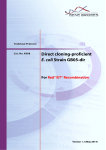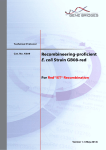Download Manual - Gene Bridges
Transcript
Technical Protocol Cat. No. K001 Quick & Easy BAC Modification Kit By Red®/ET® Recombination Version 2.9 (May 2014) CONTENTS 1 Quick and Easy BAC Modification Kit ....................................................................................... 3 2 Experimental Outline ................................................................................................................... 5 3 How Red/ET Recombination Works ........................................................................................... 7 4 Oligonucleotide Design for Red/ET Recombination ................................................................ 9 5 Media for Antibiotic Selection .................................................................................................. 10 6 Technical Protocol ..................................................................................................................... 11 6.1 Generation of a Tn5-neo PCR product flanked by homology arms ........................................... 11 6.2 Transformation with Red/ET expression plasmid pRedET ........................................................ 12 6.3 Inserting the Tn5-neo cassette into a BAC ................................................................................ 13 6.4 Verification of successfully modified BAC by PCR analysis ...................................................... 16 7 Troubleshooting......................................................................................................................... 21 8 References and Patents ............................................................................................................ 23 8.1 References ................................................................................................................................. 23 8.2 Patents ....................................................................................................................................... 24 9 Purchaser Notification/Warranty .............................................................................................. 25 10 Other products available from Gene Bridges ......................................................................... 26 11 DNA Engineering Services Available from Gene Bridges ..................................................... 30 Please read The products listed in this manual are for research purposes only. They are not designed for diagnostic or therapeutic use in humans, animals or plants. Success depends on following the protocols exactly as they are described. Do read the trouble-shooting guide before beginning your experiments. Red/ET Recombination is the intellectual property of Gene Bridges GmbH. Safety Some chemical reagents used with this system are dangerous if handled carelessly. Take care when using chemical reagents (such as isopropanol and ethidium bromide) and electrical apparatus (high-voltage power supplies, gel electrophoresis and electroporation apparatus). Follow the manufacturer’s safety recommendations. 2 Gene Bridges – Quick and Easy BAC Modification Kit, Version 2.9 (May 2014) 1 Quick and Easy BAC Modification Kit Introduction The completion of large DNA-sequencing projects, including the Human Genome Project, has generated an extraordinary amount of primary sequence data. The next major challenge is to investigate the components that make up a genome, and is often called functional genomics. Escherichia coli vectors that can contain large inserts, such as bacterial artificial chromosomes (BACs) offer several advantages for functional genomics. They can carry sufficient DNA to encompass most eukaryotic genes, including all cis-acting regulatory elements, as well as many eukaryotic gene clusters, prokaryotic regulons and many complete viral genomes, in a single molecule. However, conventional cloning methods rely on the use of restriction enzymes and in vitro purification steps, which preclude engineering of large molecules. Consequently, the usefulness of such molecules has been limited until recently. Red/ET Recombination relies on homologous recombination in vivo in E.coli and allows a wide range of modifications of DNA molecules of any size and at any chosen position. Homologous recombination is the exchange of genetic material between two DNA molecules in a precise, specific and accurate manner. These qualities are optimal for engineering a DNA molecule regardless of its size. Homologous recombination occurs through homology regions, which are stretches of DNA shared by the two molecules that recombine. Because the sequence of the homology regions can be chosen freely, any position on a target molecule can be specifically altered. Zhang and coworkers demonstrated in 1998 for the first time that a pair of phage coded proteins (RecE and RecT) only need 42 bp long homology arms to mediate the homologous recombination between a linear DNA molecule (e.g. a PCR product) and circular DNA (plasmid, BAC or E. coli chromosome). One year later the system was extended by the same group in replacing recE and recT by their respective functional counterparts of phage lambda redα and redβ (Muyrers et al. 1999). Red/ET Recombination utilizes homologous recombination and represents a revolutionary DNA engineering platform that addresses the limitations found in conventional methods. Quick and Easy BAC Modification kit The Quick and Easy BAC Modification kit is designed to introduce basic modifications such as insertions and deletions in any type of bacterial artificial chromosomes (BACs) within 1-2 weeks. Gene Bridges – Quick and Easy BAC Modification Kit, Version 2.9 (May 2014) 3 Contents of the kit: 1. pRedET (tet): Red/ET expression plasmid (20 ng/µl, 20 µl) 2. Tn5-neo template DNA: PCR-template for generating a Tn5-neomycin (kanamycin) cassette (50 ng/µl, 20 µl) 3. Tn5-neo PCR-product: Tn5-neomycin (kanamycin) cassette flanked by homology arms at the 5’ and 3’ end for the control experiment (100 ng/µl, 10 µl) 4. control BAC + pRedET (tet): Glycerol stock of E.coli strain HS996 harboring the expression plasmid pRedET (tet) as well as a pBeloBAC11 derivate for the control experiment (500 µl, 25% glycerol) 5. BAC-control-neo: Glycerol stock of E.coli strain HS996 harboring the modified pBeloBAC11 derivate (500 µl, 25% glycerol) 6. PCR primer ”oligo check-up”: Amplification primer to confirm the correct recombination in the control experiment (10 µM, 20 µl) 7. PCR primer ”oligo check-down”: Amplification primer to confirm the correct recombination in the control experiment (10 µM, 20 µl) Please store tubes 1-3 and 6-7 at -20° C, store tubes 4 and 5 at -80°C. Kit manual with protocols, maps and sequences. 4 Gene Bridges – Quick and Easy BAC Modification Kit, Version 2.9 (May 2014) 2 Experimental Outline step 1: step 2: step 3: Figure 1: Flowchart of the experimental outline for the insertion of a selectable marker gene (e.g. Tn5-neomycin/kanamycin) into a BAC. Gene Bridges – Quick and Easy BAC Modification Kit, Version 2.9 (May 2014) 5 Step 1: The E. coli strain carrying the BAC, which is to be modified, is transformed with the expression plasmid pRedET. Step 2: The expression of genes mediating Red/ET is induced by the addition of Larabinose and a temperature shift from 30°C to 37°C. After induction the cells are prepared for electroporation and the linear Tn5-neo cassette (PCR product) flanked by homology arms “hm” is electroporated. Red/ET recombination inserts the functional cassette into the target locus. Only colonies carrying the modified BAC will survive Kanamycin selection on the agar plates. Step 3: The successful integration of the selection cassette will be monitored by PCR or DNA mini preparation. 6 Gene Bridges – Quick and Easy BAC Modification Kit, Version 2.9 (May 2014) 3 How Red/ET Recombination Works In Red/ET Recombination, also referred to as -mediated recombination, target DNA molecules are precisely altered by homologous recombination in E.coli which express the phage-derived protein pairs, either RecE/RecT from the Rac prophage, or Redα/Redβ from phage. These protein pairs are functionally and operationally equivalent. RecE and Redα are 5‘- 3‘ exonucleases, and RecT and Redβ are DNA annealing proteins. A functional interaction between RecE and RecT, or between Redα and Redβ is also required in order to catalyze the homologous recombination reaction. Recombination occurs through homology regions, which are stretches of DNA shared by the two molecules that recombine (Figure 2). The recombination is further assisted by -encoded Gam protein, which inhibits the RecBCD exonuclease activity of E.coli. Figure 2: Mechanism of Red/ET Recombination. Double-stranded break repair (DSBR) is initiated by the recombinase protein pairs, RecE/RecT or Red/Red Gene Bridges – Quick and Easy BAC Modification Kit, Version 2.9 (May 2014) 7 First Red (or RecE) digests one strand of the DNA from the DSB, leaving the other strand as a 3’ ended, single-stranded DNA overhang. Then Red (or RecT) binds and coats the single strand. The protein-nucleic acid filament aligns with homologous DNA. Once aligned, the 3’ end becomes a primer for DNA replication. The recombination proteins can be expressed from a plasmid (Figure 7) and are therefore transferable to any E. coli strain. pRedET (Figure 7) carries the λ phage red operon expressed under the control of the arabinose-inducible pBAD promoter (Guzman et al. 1995) and confers Tetracycline resistance. The pBAD promoter is both positively and negatively regulated by the product of the araC gene (Schleif, 1992). AraC is a transcriptional regulator that forms a complex with L-arabinose. Arabinose binds to AraC and allows transcription to begin. In the presence of glucose or the absence of arabinose, transcription is blocked by the AraC dimer. The plasmid carries the red, , genes of the phage together with the recA gene in a polycistronic operon under the control of an inducible promoter. The recombination window is therefore limited by the transient expression of Red proteins. Thus, the risk of unwanted intra-molecular rearrangement is minimized. While constitutive expression of the redγ gene has a toxic effect in (recA-) cells like DH10B or HS996 under some conditions, thus limiting the efficiency of recombination, tightly regulated expression of the γ gene together with simultaneous expression of the redα and β genes allows efficient homologous recombination between linear DNA fragments and plasmids resident in cells such as DH10B. pRedET is a derivative of a thermo-sensitive pSC101 replicon, which is a low copy number plasmid dependent on oriR101. The RepA protein encoded by plasmid pSC101 is required for plasmid DNA replication and the partitioning of plasmids to daughter cells at division (Miller, Ingmer and Cohen, 1995). Because the RepA protein is temperature-sensitive (Ts), cells have to be cultured at 30°C to maintain the plasmid. pSC101 derivatives are easily curable at 37°C to 43°C. Experiments have shown that the copy number of the plasmid decreases by about 80% during four generations of bacterial cell growth at 42°C. After return of the cultures to 30°C, approximately the same number of generations of bacterial cell growth is required for the copy number of the plasmid to return to the level observed before (Miller, Ingmer and Cohen, 1995). Since the plasmid is based on oriR101 it can be propagated in E.coli together with most ColE1-derived plasmids. 8 Gene Bridges – Quick and Easy BAC Modification Kit, Version 2.9 (May 2014) 4 Oligonucleotide Design for Red/ET Recombination To target your BAC at the site(s) you choose, you will need to attach short homology regions to a selectable marker. This is most conveniently done by ordering two oligonucleotides for use in PCR amplification (see Figure 3). Each oligonucleotide consists of two (or, if desired, three) parts: 1. Required Part A (A’ for the other oligonucleotide) is the homology region, shared by the target molecule and the linear molecule. Choose the way you want to engineer your BAC. Often, you want to delete a section of your BAC. This is accomplished by replacing this section with the selectable marker. The homology regions are the 50bps directly adjacent to either side of the deleted section. You can delete from 0 bp (i.e. make an insertion) to >100 kb. The exact sequences of the homology regions can be chosen freely, according to which position on the target molecule will be modified. 2. Optional Part B (B´ for the other oligonucleotide): This part of the oligonucleotide allows useful sequences, such as HA-tags, Myc-tags, His-tags, or restriction sites, multiple cloning sites, site-specific recombination target sites, etc., to be incorporated into the recombinant product. By design, these will be incorporated into the recombinant product exactly where desired. If the introduction of such operational sequences is not needed, this piece can simply be omitted from the oligonucleotide design. 3. Required Part C (C’ for the other oligonucleotide): This piece, usually 18 to 24 nucleotides long, primes the PCR amplification of the selectable marker from the provided template (sequences are given on page 20). Figure 3: Practical steps involved in Red/ET. Fig. 3 illustrates the principle for modifying episomes such as bacterial artificial chromosomes (BACs). See text above for further details. Sm, selectable marker; the small blue arrow indicates a prokaryotic promoter. Gene Bridges – Quick and Easy BAC Modification Kit, Version 2.9 (May 2014) 9 5 Media for Antibiotic Selection All antibiotics are available from Sigma. Stock solutions should be stored at -20ºC. For selective LB medium, the antibiotic is dissolved in LB medium to the indicated working concentration: 1. Chloramphenicol stock solution c = 30 mg/ml dissolved in ethanol. Working concentration 15 g/ml for BACs, 50 µg/ml for high-copy plasmids. 2. Tetracycline stock solution c = 10 mg/ml dissolved in 75% ethanol. Working concentration for pRedET is 3 g/ml. Tetracycline is light sensitive. 3. Kanamycin stock solution c = 30 mg/ml dissolved in ddH20. Working concentration 15 g/ml for BACs, 50 µg/ml for high-copy plasmids. Selective LB plates are made by adding 15 g agar to 1 L LB medium. After boiling, cool to approx. 50°C, add the required antibiotics to yield the appropriate working concentrations and pour into petri dishes. L-arabinose stock solution Use 10% L-arabinose (Sigma A-3256) in ddH2O, fresh or frozen in small aliquots at -20°C. Use 50 µl stock solution per 1.4 ml LB for induction of recombination protein expression from pRedET. Frozen aliquots should not undergo more than three freeze-thaw cycles. 10 Gene Bridges – Quick and Easy BAC Modification Kit, Version 2.9 (May 2014) 6 Technical Protocol 6.1 Generation of a Tn5-neo PCR product flanked by homology arms Oligo design Please follow the advice in Oligonucleotide Design (page 9) for Red/ET Recombination. The example used for the positive control reaction included in this kit is presented. i. Choose 50 nucleotides directly adjacent to the left of the site you want to change. Order an oligonucleotide with this sequence at the 5’ end. At the 3’ end of this oligo include the PCR primer sequence for amplification of the Tn5-neo selection cassette, given in italics below. Upper oligonucleotide: 5’-(N)50 TGGACAGCAAGCGAACCGGAATTGC -3’ ii. Choose 50 nucleotides directly adjacent to the right of the site you want to change and transfer them into the reverse complement orientation. Order an oligonucleotide with this sequence at the 5’ end. At the 3’ end of this oligo, include the 3’ PCR primer sequence for the Tn5-neo selection cassette, given in italics below. Lower oligonucleotide: 5’-(N)50 TCAGAAGAACTCGTCAAGAAGGCG -3’ If desired, include restriction sites or other short sequences in the ordered oligo(s) between the 5’ homology regions and the 3’ PCR primer sequences. PCR The oligonucleotides are suspended in ddH2O at a final concentration of 10 μM. We present as an example a standard PCR protocol for the use of Phusion DNA Polymerase (Finnzyme). However, any other DNA Polymerase together with the corresponding PCR protocol according to the instructions of the manufacturer should yield satisfactory results. PCR reaction (in 50 μl) 34.5 μl 10.0 μl 2.0 μl 1.0 μl 1.0 μl 1.0 μl 0.5 μl dH2O 5 x HF PCR reaction buffer 5 mM dNTP upper oligonucleotide lower oligonucleotide Tn5-neo PCR-template (tube 2) Phusion polymerase (5 U/μl) Gene Bridges – Quick and Easy BAC Modification Kit, Version 2.9 (May 2014) 11 An annealing temperature of 57- 62C is optimal. PCR Profile: Initial denaturation step 30 sec 98°C; thirty cycles: 10 sec 98°C, 30 sec 55°C, 90 sec 72°C; final elongation step 10 min 72°C. Check a 5 µl aliquot of the PCR product on a gel to ensure the PCR was successful. The size of the PCR product for the Tn5-neo cassette is 1082bp. Purify the PCR product either by running the whole PCR sample on an agarose gel and subsequent gel extraction or directly by Spin Column (e.g. “Min Elute Gel Extraction Kit“; Qiagen). Adjust the DNA concentration to 100 ng/µl. 6.2 Transformation with Red/ET expression plasmid pRedET Before starting with the experiment, please streak out the glycerol stock of the BAC clone you obtained from the stock center on LB plates conditioned with Chloramphenicol. Day 1: 1. Set up an overnight culture. Pick one or two colonies and inoculate them in microfuge tubes containing 1.0 ml LB medium with appropriate antibiotics to select for your BAC. Puncture a hole in the lid for air. Incubate at 37°C overnight with shaking. Day 2: Before starting: Chill ddH2O (or 10% glycerol) on ice for at least 2 h. Chill electroporation cuvettes (1 mm gap). Cool benchtop centrifuge to 2°C. 1. Set up one or two microfuge tubes containing fresh 1.4 ml LB medium with appropriate antibiotics and inoculate with 30 µl of fresh overnight culture. 2. Culture for 2-3 h at 37°C, shaking at 1000 rpm. 3. Prepare the cells for electroporation Centrifuge for 30 sec at 11,000 rpm in a cooled microfuge benchtop centrifuge (at 2°C). Discard the supernatant by quickly tipping out the supernatant twice, and place the pellet on ice. Resuspend the pellet with 1 ml chilled ddH2O, pipetting up and down three times to mix the suspension. Repeat the centrifugation and resuspend the cells again. Centrifuge and tip out the supernatant once more; 20 to 30 μl will be left in the tube with the pellet. Resuspend cells and keep the tube on ice. 12 Gene Bridges – Quick and Easy BAC Modification Kit, Version 2.9 (May 2014) 4. Take the Red/ET Recombination protein expression plasmid pRedET (tube 1). Add 1 μl to your cell pellet. Mix briefly. Keep the tube on ice. Transfer the cell suspension from the tube to the chilled electroporation cuvette. 5. Electroporate at 1350 V, 10F, 600 Ohms. This setting applies to an Eppendorf® Electroporator 2510 using a 1 mm electroporation cuvette. Other devices can be used, but 1350 V and a 5 ms pulse are recommended. 6. Resuspend the electroporated cells in 1 ml LB medium without antibiotics and return them to the microfuge tube. 7. Incubate at 30°C for 70 min, shaking at 1000 rpm. (The Red/ET expression plasmid pRedET will be lost at 37°C). 8. Using a small loop, plate 100 μl cells on LB agar plates containing Tetracycline (3 μg/ml) plus Chloramphenicol (15 µg/ml) for the BAC. Incubate the plates at 30°C overnight (or for at least 15 h). Protect the plates from light by wrapping them up, because Tetracycline is sensitive to light. Make sure the cells stay at 30°C, otherwise the Red/ET plasmid will be lost. 6.3 Inserting the Tn5-neo cassette into a BAC In the next step, prepare electro-competent cells from the BAC hosts that contain the Red/ET expression plasmid, shortly after inducing the expression of the recombination proteins. In advance, prepare the linear DNA fragment (the Tn5-neo selection cassette) with homology arms that you will insert into your BAC. Use tube 3 (Tn5-neo PCR-product) and tube 4 (control BAC + pRedET) to perform a control experiment in parallel. Day 3: 1. To start overnight cultures, pick one colony from the plate you obtained in 6.2, step 8 and inoculate one microfuge tube containing 1.0 ml LB medium plus Tetracycline (3 µg/ml) and Chloramphenicol (15 µg/ml) for the BAC. Also pick one colony from the control plate. Puncture a hole in the lid of the tubes for air. Incubate the cultures while shaking at 30°C overnight. Day 4: Before starting: Chill ddH2O (or 10% glycerol) on ice for at least 2 h. Chill electroporation cuvettes (1 mm gap). Cool benchtop centrifuge to 2°C. Gene Bridges – Quick and Easy BAC Modification Kit, Version 2.9 (May 2014) 13 2. The next day, set up 4 lid-punctured microfuge tubes (2 for your own experiment and 2 for control experiment) containing 1.4 ml fresh LB medium conditioned with the same antibiotics as in step 1. Inoculate two of them with 30 µl fresh overnight culture for your experiment, the other two with 30 µl of the overnight culture from the control. Incubate the tubes at 30°C for 2 h, shaking at 1100 rpm until OD600 ~ 0.3. 3. Add 50 μl 10% L-arabinose to one of the tubes for your own experiment and to one of the control tubes, giving a final concentration of 0.3%-0.4%. This will induce the expression of the Red/ET Recombination proteins. Do not use Darabinose. Leave the other tubes without induction as negative controls. Incubate all at 37°C, shaking for 45 min to 1 h. Note: It is important that cells are incubated at 37°C, the temperature at which all proteins necessary for the subsequent recombination are expressed. There are about 5 copies of this temperature-sensitive plasmid per cell, and during one hour there is approximately 1 doubling step, meaning any daughter cell will still have on average 2-3 copies left and will also go on expressing the recombination proteins. The plasmid is actually lost after electroporation and recombination, when cells are incubated at 37°C overnight. 4. Prepare the cells for electroporation Centrifuge for 30 sec at 11,000 rpm in a cooled microfuge benchtop centrifuge (at 2°C). Discard the supernatant by quickly tipping it out twice, and place the pellet on ice. Resuspend the pellet with 1 ml chilled ddH2O, pipetting up and down three times to mix the suspension. Repeat the centrifugation and resuspend the cells again. Centrifuge and tip out the supernatant once more; 20 to 30 μl will be left in the tube with the pellet. Resuspend cells and keep the tubes on ice. 5. Add 1-2 μl (100-200 ng) of the linear Tn5-neo cassette to the pellet to each of the two microfuge tubes (induced and uninduced), and pipette the mixture into the chilled electroporation cuvettes. In parallel, pipette 1 µl from tube 3 into each of the two tubes of the control. 6. Electroporate at 1350 V, 10 F, 600 Ohms. This setting applies to an Eppendorf® Electroporator 2510 using an electroporation cuvette with a slit of 1 mm. Other devices can be used, but 1350 V and a 5 ms pulse are recommended. 7. Add 1 ml LB medium without antibiotics to the cuvette. Mix the cells carefully by pipetting up and down and pipette back into the microfuge tube. Incubate the cultures at 37°C with shaking for 70 minutes. Recombination will now occur. 8. Streak the cultures with a loop (100µl is sufficient, if necessary plate all) onto LB agar plates containing Chloramphenicol (15 μg/ml) and Kanamycin (15 μg/ml). The plates should not contain Tetracycline; otherwise the Red/ET Recombination protein expression plasmid will either persist or the cells will die. 9. Incubate the plates at 37 °C over night. The Red/ET recombination protein expression plasmid (pRedET) will disappear at 37 °C. 14 Gene Bridges – Quick and Easy BAC Modification Kit, Version 2.9 (May 2014) You should obtain >500 colonies and the ratio of induced : uninduced bacterial colonies should exceed 100 : 1. An example is shown in Figure 4. Figure 4: Typical result of a Red/ET recombination experiment. On the left plate the arabinose induced sample was streaked on a LB plated conditioned with Chloramphenicol (15 μg/ml) and Kanamycin (15 μg/ml). The right plate shows the result of the uninduced control plate. Nearly all colonies growing on the agar plates conditioned with the appropriate antibiotics will have successfully recombined by Red/ET. Notably, although most kanamycin-resistant colonies will contain the correct BAC recombinant, it is possible that secondary recombination, usually deletions between internal repeats in the BAC, can also occur. The frequency of secondary recombination events varies greatly from one BAC to another. To find out which clones have been modified without rearrangement, isolate the BAC DNA. Pick 10-20 colonies from the experiment and 2 from the control. Also pick colonies from the original unmodified BAC plates for DNA preparation and comparison. Analyze these DNA preparations using a) Restriction digestion of mini-prep DNA followed by electrophoresis (this is our preferred method because secondary recombination events can be detected) and/or b) PCR amplification of the insertion site using externally located primers with subsequent sequencing across the recombination site(s). As a further control, tube 5 contains E. coli harboring the correctly modified product of the control reaction. Gene Bridges – Quick and Easy BAC Modification Kit, Version 2.9 (May 2014) 15 6.4 Verification of successfully modified BAC by PCR analysis Analyze several colonies by colony PCR (e.g. pick a single colony and resuspend it in 30 µl of sterile water. Boil the sample at 98°C for 5 minutes and take an aliquot of 2 µl of the suspension as template for your PCR reaction). Two pairs of control primers are included in the kit (tube 6 and 7). The primers bind to the pBeloBAC11 backbone and amplify a 1066bp fragment from the unmodified control BAC, and a 1133 bp fragment after insertion of the neomycin cassette (Figure 5). As a further control, restriction digestion of mini-prep DNA can be performed (Figure 6). Figure 5: PCR results verifying the successful Red/ET Recombination. M: 1 kb ladder from Gibco. Lanes 1 to 3: unmodified control BAC resulting in a 1066 bp band. Lanes 4 to 12: successfully modified BACs containing the inserted Tn5-Neo cassette resulting in a 1133 bp band. Figure 6: Restriction analysis of original and modified BACs after XhoI digestion. M: 1 kb ladder from Gibco. Lanes 1 to 3: unmodified BACs. Lanes 4 to 12: successfully modified BACs with the inserted Tn5-neo cassette. 16 Gene Bridges – Quick and Easy BAC Modification Kit, Version 2.9 (May 2014) Protocol: Preparation of BAC DNA for analytical purposes 1. Pick colonies and inoculate 2 ml of LB culture containing the appropriate antibiotics. Incubate at 37°C over night with shaking at 1100 rpm. (Next day) 2. Spin down the 2 ml overnight cultures for 1 min at 13,200 rpm. 3. Discard the supernatant and resuspend the cell pellet in 200 µl buffer P1 with RNase (from QIAGEN DNA Maxi-preparation Kit). 4. Add 200 µl of buffer P2 (Qiagen) and mix by inverting the tube several times. 5. Add 200 µl of buffer P3 (Qiagen) and mix by inverting the tube several times. 6. Spin down the white lysate at highest speed for 15 min. 7. Transfer the clear supernatant into a new 1.5ml-Eppendorf tube and add 0.50 ml of 2-propanol. 8. Mix by inverting the tube and spin down the DNA at highest speed for 15 min. 9. Discard the supernatant and add 0.5 ml of 70% ethanol to rinse the pellet (be careful not to loose the small white pellet). 10. Spin down the DNA at highest speed for 10 min. 11. Clean the inner wall of the tube with a piece of tissue or cotton stick. 12. Dry the pellet under the speed vacuum for 2 min or leave the tube open on the bench for 5 to 10 min until the DNA pellet is completely dry. Do not overdry the pellet otherwise the DNA will become difficult to re-dissolve. 13. Resuspend the dry DNA pellet in 30 l ddH2O. Gene Bridges – Quick and Easy BAC Modification Kit, Version 2.9 (May 2014) 17 6.5 Maps and Sequences Figure 7: Map of the Red/ET expression plasmid pRedET (tet). Transformation of E.coli hosts with this plasmid is selected for by acquisition of Tetracycline resistance at 30°C. Expression of the Red/ET Recombination proteins is induced by L-arabinose activation of the BAD promoter at 37°C. 18 Gene Bridges – Quick and Easy BAC Modification Kit, Version 2.9 (May 2014) Figure 8: Map of the Tn5-neo selection cassette. Gene Bridges – Quick and Easy BAC Modification Kit, Version 2.9 (May 2014) 19 Oligonucleotides used for the control reaction included in this kit: The two oligonucleotides labeled ‘check-up’ and ‘check-down’ are designed for verification of the correctly recombined BAC clones by PCR. They are supplied with the kit (tubes 6 and 7). ‘check-up’: 5’-GTCGATCAGACTATCAGCGTGAG-3’ ‘check-down’: 5’-TACCGAGCTCGAATTCGCCCTATAG-3’ The oligos below were used to add the 50 bp homology regions (italics) for Red/ET recombination to the neomycin/kanamycin selection cassette used in the control reaction. The parts of the oligos which serve as PCR primers for amplification of the Tn5-neo cassette are underlined. An additional XhoI site (bold) was introduced between the homology region and the PCR primer of the ‘lower’ oligonucleotide. These two oligos are not supplied with the kit. Upper: 5’TAGAACGGAGTAACCTCGGTGTGCGGTTGTATGCCTGCTGTGGATTGCTGCTG GACAGCAAGCGAACCGGAATTGC-3’ Lower: 5’TACCGAGCTCGAATTCGCCCTATAGTGAGTCGTATTACAATTCACTGGCCCTCG AGTCAGAAGAACTCGTCAAGAAGGCG-3’ 20 Gene Bridges – Quick and Easy BAC Modification Kit, Version 2.9 (May 2014) 7 Troubleshooting Problems with the recombination reaction can be caused by a number of different factors. Please review the information below to troubleshoot your experiments. We highly recommend performing a positive control experiment using the components provided in the kit. For homologous recombination the two DNA molecules must share two regions of perfect sequence identity. Several wrong nucleotides in the homology region can completely abolish recombination. Since oligonucleotides are used to add the homology regions they have to be synthesized properly and be of excellent quality. Take into account that long oligonucleotides (especially if they are longer than 80bp) require additional purification steps, such as HPLC. Also note that the electronic sequences provided for BACs may not be 100% correct. If you are trying to target a repeated sequence in your BAC, you may experience problems because the homology region at the end of the linear fragment can go to more than one site. It is therefore best not to target repeats directly. Observation: No colonies on your plate after Red/ET Recombination: If you do not obtain any colonies after recombination, the following parameters should be checked: 1) The PCR product - could be wrong (check it by restriction digest or sequencing) - could be degraded (check an aliquot on an agarose gel) - could have incorrect homology arms. Please double-check the oligonucleotides used to generate the homology arms for quality and correctness. If necessary verify the sequence by sequencing of the PCR product. - may not be enough; increase the amount of PCR product from approximately 200 ng up to 500 ng. Please take into consideration that you may also increase non-specific background. 2) The BAC - may be instable and may have rearranged. Digest the BAC and run on a gel (preferably PFGE) to confirm the approximate size. - may contain some repeats in the region you are targeting. Re-check sequence. - could be wrong; make sure that you have the right BAC by isolating DNA and checking the region of the homology arms by PCR. If necessary sequence the PCR product to verify the region of homology. Some BACs are wrongly annotated, inherently instable or a mixture of more than one BAC. Gene Bridges – Quick and Easy BAC Modification Kit, Version 2.9 (May 2014) 21 3) The Red/ET reaction did not take place because - there was no expression plasmid present in the cells; e.g. the cells were grown at 37°C instead of 30°C (check for tet resistance), - no or the wrong type of arabinose was used for induction (please make sure you use L-arabinose!) - some strains (e.g. JM109, DH5alpha) are less efficient in Red/ET Recombination than others. DH10B, HS996, GeneHogs or TOP10 are our preferred strains. - in very rare cases an elongation of the reaction time for the recombination from 70 min (incubation of electroporation) to up to four hours is necessary for successful recombination. 4) Problems with and after the electroporation: - cells are not competent enough to take up the linear DNA fragment. Please make sure that the cells were kept on ice and that the water (respectively 10% glycerol) is sufficiently cold. Linear DNA has been shown to be about 104-fold less active than DNA transformed in circular form (Eppendorf Operation Manual Electroporator 2510 version 1.0). Make sure that the time constant is around 5 ms. - please make sure that there is no arching during the electroporation process. - please make sure that after electroporation the cells are plated on the appropriate concentration of antibiotics depending on the copy number of the plasmid or BAC (see page 9). Similar number of colonies on both plates, the induced and the un-induced one: If you obtain a high number of colonies on both plates, it indicates that there are still traces of the circular (or supercoiled) plasmid used to prepare the linear fragment left in the sample. Since the transformation efficiency of linear fragments is 104-fold less than of circular DNA molecules you may obtain a background even if no traces were visible on an agarose gel. If the linear DNA fragment was obtained by restriction digestion, use less DNA and gel purify the fragment! If the linear cassette was obtained by PCR, set up a DpnI digest for your PCR product and gel purify it at the end! If you obtain a very low number of colonies on both plates, it indicates that the overall efficiency of Red/ET Recombination is very low. In this case please control all parameters mentioned in the section for “no colonies after Red/ET Recombination”. 22 Gene Bridges – Quick and Easy BAC Modification Kit, Version 2.9 (May 2014) 8 References and Patents 8.1 References Angrand P.O., Daigle N., van der Hoeven F., Scholer H.R. and Stewart A.F. Simplified generation of targeting constructs using ET recombination. Nucleic Acids Res 27, e16 (1999). Guzman L.M., Belin D., Carson M.J., Beckwith J. Tight regulation, modulation, and high-level expression by vectors containing the arabinose pBAD promoter. J Bacteriol 177, 4121-4130 (1995). Hill F., Benes V., Thomasova D., Stewart A.F., Kafatos F.C., Ansorge W. BAC trimming: minimizing clone overlaps. Genomics 64, 111-113 (2000). Miller C.A., Ingmer H. and Cohen SN. Boundaries of the pSC101 Minimal Replicon are Conditional. J Bacteriol 177, 4865-4871 (1995). Muyrers, J.P.P., Zhang, Y., Testa, G., Stewart, A.F. Rapid modification of bacterial artificial chromosomes by ET-recombination. Nucleic Acids Res. 27, 1555-1557 (1999). Muyrers, J.P.P., Zhang, Y., Buchholz, F., Stewart, A.F. RecE/RecT and Red/Red initiate double-stranded break repair by specifically interacting with their respective partners. Genes Dev 14, 1971-1982 (2000). Muyrers J.P.P., Zhang Y., Benes V., Testa G., Ansorge W., Stewart A.F. Point mutation of bacterial artificial chromosomes by ET recombination. EMBO Reports 1, 239-243 (2000). Muyrers, J.P.P., Zhang, Y., Stewart, A.F. ET cloning: Think recombination first. Genetic Engineering, Principles and Methods (Ed. J.K. Setlow), 22, 77-98 Kluwer Academic/Plenum Publishers, NY. (2000). Muyrers, J.P.P., Zhang, Y. and Stewart, A.F. Recombinogenic engineering: new options for cloning and manipulating DNA. Trends in Bioch. Sci. 26, 32531 (2001). Narayanan K., Williamson R., Zhang Y., Stewart A.F., Ioannou P.A. Efficient and precise engineering of a 200 kb beta-globin human/bacterial artificial chromosome in E. coli DH10B using an inducible homologous recombination system. Gene Ther. 6, 442-447 (1999). Schleif, R.S. DNA Looping, Annu. Rev. Biochem. 61, 199-223 (1992) Testa G., Zhang Y., Vintersten K., Benes V., Pijnappel P., Chambers I., Smith A.J.H., Smith A.G. and Stewart A.F. Engineering of mouse genome with bacterial artificial chromosomes to create multipurpose alleles. Nature Biotechnology. 21, 443-7 (2003). Gene Bridges – Quick and Easy BAC Modification Kit, Version 2.9 (May 2014) 23 Testa G., Schaft J., van der Hoeven F., Glaser S., Anastassiadis K., Zhang Y., Hermann T., Stremmel W. and Stewart A.F. A reliable lacZ expression reporter cassette for multipurpose, knockout-first alleles. Genesis 38, 151-158 (2004). Zhang, Y., Buchholz, F., Muyrers, J.P.P., and Stewart, A.F. A new logic for DNA engineering using recombination in Escherichia coli. Nature Genetics 20, 123-128 (1998). Zhang, Y., Muyrers, J.P.P., Testa, G., and Stewart, A.F. DNA cloning by homologous recombination in Escherichia coli. Nature Biotech. 18, 1314-1317 (2000). Zhang, Y., Muyrers, P.P.J., Rientjes, J., and Stewart, A.F. Phage annealing proteins promote oligonucleotide-directed mutagenesis in Escherichia coli and mouse ES cells. BMC Molecular Biology. 4, 1-14 (2003). 8.2 Patents Red/ET recombination is covered by one or several of the following patents and patent applications: Stewart, A.F., Zhang, Y., and Buchholz, F. 1998. Novel DNA cloning method. European Patent No.1034260 (issued on 12th of March, 2003), United States Patent No 6,509,156. Stewart, A.F., Zhang, Y., and Muyrers, J.P.P. 1999. Methods and compositions for directed cloning and subcloning using homologous recombination. United States Patent No. 6,355,412 (issued on 12th of March, 2002). Youming Zhang, A. Francis Stewart, and Joep P.P. Muijrers. 2001. Improved RecT or RecET cloning and subcloning method. European Patent Application No. 01 117 529.6 Stewart, A.F., Zhang, Y., and Muyrers, J.P.P. 2001. Recombination method. European Patent Application No. 0103276.2 These patents and patent applications are owned by Gene Bridges, or owned by the EMBL and exclusively licensed to Gene Bridges. 24 Gene Bridges – Quick and Easy BAC Modification Kit, Version 2.9 (May 2014) 9 Purchaser Notification/Warranty This product is the subject of European Patent No.1034260 (issued on 12th of March, 2003) (or PCT/EP98/07945) and United States Patent No. 6,355,412 (issued on 12th of March, 2002). The purchase of this product conveys to the purchaser the nontransferable right to use this product for research purposes only. The purchaser can not sell or otherwise transfer this product or its components to a third party. No rights are conveyed to the purchaser to use this product or its components for a commercial purpose. Commercial purposes shall include any activity for which a party receives consideration of any kind. These may include, but are not limited to, use of the product or its components in manufacturing, to provide a service, information or data, use of the product for diagnostic purposes, or re-sale of the product or its components for any purpose, commercial or otherwise. The use of homologous recombination for commercial purposes may infringe the intellectual property covered by the EP 419,621 patent family. Products containing the araB promoter are sold under patent license for research purposes only and are non-transferable. Inquiries for any commercial use, including production of material to be sold commercially or used in production or in product development efforts which includes efforts toward regulatory approval, should be made directly to Xoma Corporation, Berkeley, California. Xoma Corporation 2910 Seventh Street Berkeley, CA 94710 Limited Warranty Gene Bridges is committed to providing customers with high-quality goods and services. Gene Bridges assumes no responsibility or liability for any special, indirect, incidental or consequential loss or damage whatsoever. This warranty limits Gene Bridges GmbH’s liability only to the cost of the product. Gene Bridges – Quick and Easy BAC Modification Kit, Version 2.9 (May 2014) 25 10 Other products available from Gene Bridges General information Kits are available for non-commercial research organizations. Commercial companies or for-profit organizations require a sub-license to use Red/ET Recombination. The complete product list as well as the all information how to order the kits in your country is given on our website: www.genebridges.com K002: Counter-Selection BAC Modification Kit Description: Contents: 26 This kit is designed to modify any type of bacterial artificial chromosomes (BACs) within 2-3 weeks by using a counter-selection cassette The kit is designed for advanced BAC modification such as introducing short sequences (e.g. point mutations, loxP sites, restriction sites, etc.), insertion or deletion of non-selectable marker genes, fragment exchange without leaving a selection marker or any unwanted sequences. The included counter-selection cassette pRpsL-neo is based on Streptomycin selection which shows a much higher efficiency than pSacB-neo or comparable systems. This kit can also be used to work on bacterial chromosomes and common ColE1 origin plasmids. High Red/ET efficiency plus convenient removal of the Red/ET Recombination protein expression plasmid pRedET after recombination. Red/ET Recombination protein expression plasmid pRedET. Any E. coli strain can be made Red/ET proficient by transformation with this plasmid. BAC host E.coli strain HS996 already carrying the Red/ET plasmid. pRpsL-neomycin template to be used for your own experiments. Positive controls to introduce a point-mutation in a 150 kb BAC. Detailed protocols, descriptions of plasmids, maps and sequences. Gene Bridges – Quick and Easy BAC Modification Kit, Version 2.9 (May 2014) K003: BAC Subcloning Kit Description: Contents: This kit is optimized for subcloning of DNA fragments from BACs and cosmids. No restriction sites necessary. Fragments up to 20 kb can be subcloned. High Red/ET efficiency plus convenient removal of the Red/ET Recombination protein expression plasmid pRedET after recombination. Red/ET Recombination protein expression plasmid pRedET. Any E. coli strain can be made Red/ET proficient by transformation with this plasmid. Linear vector carrying a ColE1 origin of replication plus ampicillin resistance gene to be used for the subcloning experiment. Positive controls to subclone a 15 kb fragment from a control BAC into the vector delivered with the kit. Detailed protocols, descriptions of plasmids, maps and sequences. K004: Quick and Easy Conditional Knockout Kit (FRT/FLPe) and K005: Quick and Easy Conditional Knockout Kit (loxP/Cre) Description: This kit is designed to integrate FRT or loxP sites into large vectors at any position within 2 weeks. Single FRT or loxP sites are inserted by Red/ET recombination of FRT or loxP flanked functional cassettes into any designated locus with subsequent removal of the selection marker by FLPe or Cre recombinases. Conditional targeting constructs can be generated either by a repetitive insertion of the functional cassette supplied with the kit or by combination with other functional cassettes offered by Gene Bridges. The functional cassette supplied with the kit (FRT-PGK-gb2-neoFRT or loxP-PGK-gb2-neo-loxP) combines a prokaryotic promoter (gb2) for expression of Kanamycin resistance in E. coli with an eukaryotic promoter (PGK) for expression of Neomycin resistance in mammalian cells. High Red/ET efficiency plus convenient removal of the Red/ET Recombination protein expression plasmid pRedET after recombination. Gene Bridges – Quick and Easy BAC Modification Kit, Version 2.9 (May 2014) 27 Contents: Red/ET Recombination protein expression plasmid pRedET. Any E. coli strain can be made Red/ET proficient by transformation with this plasmid. FRT or loxP flanked Kan/Neo resistance template (FRT-PGK-gb2neo-FRT or loxP-PGK-gb2-neo-loxP) to be used for your own experiments. Expression plasmid for FLPe or Cre site specific recombinase in E. coli cells Positive controls to introduce a single FRT site into a 15 kb high copy plasmid. Detailed protocols, descriptions of plasmids, maps and sequences. K006: Quick and Easy E.coli Gene Deletion Kit Description: Contents: 28 This kit is designed to knock-out or alter genes on the E. coli chromosome in less than one week. Red/ET recombination allows the exchange of genetic information in a base pair precise, specific, and faithful manner. An FRT-flanked Kanamycin resistance marker cassette is supplied with the kit which can be used to replace a gene on the E. coli chromosome. Red/ET recombination can replace fragments as large as 30kb from the chromosome. The use of a FRT-flanked resistance cassette for the replacement of the targeted gene allows the subsequent removal of the selection marker by a FLP-recombinase step, if required. (FLP expression plasmids can be purchased from Gene Bridges). Multiple knock-outs can be generated either by a repetitive insertion of the functional cassette supplied with the kit or by combination with other functional cassettes offered by Gene Bridges. Strictly controlled recombination process due to an optimized design of the pRedET expression plasmid. The genes for the Recombination proteins are under the control of an inducible promoter and the plasmid carries a temperature sensitive origin of replication for a convenient removal of the plasmid after recombination. Two Red/ET Recombination protein expression plasmids pRedET (tet) and pRedET (amp). Any E. coli strain can be made Red/ET proficient by transformation with these plasmids. FRT flanked Kanamycin resistance template (FRT-PGK-gb2-neoFRT) to be used for your own experiments. Positive controls to replace the gene for mannose transporter (manX) on the E. coli chromosome. Detailed protocols, descriptions of plasmids, maps and sequences. Gene Bridges – Quick and Easy BAC Modification Kit, Version 2.9 (May 2014) Additional functional cassettes: A001: Pro- and Eukaryotic Neomycin Selection Cassette (PGK-gb2-neo) A002: FRT flanked, Pro- and Eukaryotic Neomycin Selection Cassette (FRT-PGK-gb2-neo-FRT) A003: loxP flanked, Pro- and Eukaryotic Neomycin Selection Cassette (loxP-PGK-gb2-neo-loxP) A004: FRT flanked, Pro- and Eukaryotic Neomycin Selection Cassette plus loxP site (FRT-PGK-gb2-neo-FRT-loxP) A005: FRT flanked, Pro- and Eukaryotic Neomycin Selection Cassette plus loxP site 2nd version (loxP-FRT-PGK-gb2-neo-FRT) A006: FRT flanked Chloramphenicol Selection Cassette (FRT-cm-FRT) A007: loxP flanked Chloramphenicol Selection Cassette (loxP-cm-loxP) A008: FRT flanked Ampicillin Selection Cassette (FRT-amp-FRT) A009: loxP flanked Ampicillin Selection Cassette (loxP-amp-loxP) A010: FRT flanked, Pro- and Eukaryotic Hygromycin Selection Cassette (FRT-PGK-gb2-hygro-FRT) A011: loxP flanked, Pro- and Eukaryotic Hygromycin Selection Cassette (loxP-PGK-gb2-hygro-loxP) Additional strains and plasmids: A104: Enhanced FLP Expression Plasmid 707-FLPe with tetracycline resistance marker for use in E. coli only A105: Enhanced FLP Expression Plasmid 708-FLPe with chloramphenicol resistance marker for use in E. coli only A112: Cre Expression Plasmid: 705-Cre (cm resistance marker) A113: Cre Expression Plasmid: 706-Cre (tet resistance marker) A201: Enhanced Eukaryotic FLP Expression Plasmid: pCAGGS-FLPe Gene Bridges – Quick and Easy BAC Modification Kit, Version 2.9 (May 2014) 29 11 DNA Engineering Services Available from Gene Bridges Instead of performing your own DNA manipulations, let the Gene Bridges DNA Engineering Service do the work for you. We work for many commercial and research organisations across the world to provide DNA modifications in low- or highcopy plasmids, cosmids, BACs and the E.coli chromosome. The available DNA modifications are: Insertion of a selectable or non-selectable marker cassette Deletion of sequences of any size, ranging from 1 bp up to more than 100 kb with or without leaving a selectable marker Replacement of genes on the E.coli chromosome Point mutations Fusions Introduction of site specific targeting sites (loxP, FRT, etc.) Insertion of restriction enzyme recognition sites Subcloning of DNA pieces up to 60 kb Transferring DNA fragments into multiple destination vectors BAC and cosmid stitching Substitutions Contact our DNA Engineering Service by email to [email protected], or go to www.genebridges.com for details and prices. 30 Gene Bridges – Quick and Easy BAC Modification Kit, Version 2.9 (May 2014) This page intentionally left blank Gene Bridges – Quick and Easy BAC Modification Kit, Version 2.9 (May 2014) 31 32 Gene Bridges – Quick and Easy BAC Modification Kit, Version 2.9 (May 2014)
































